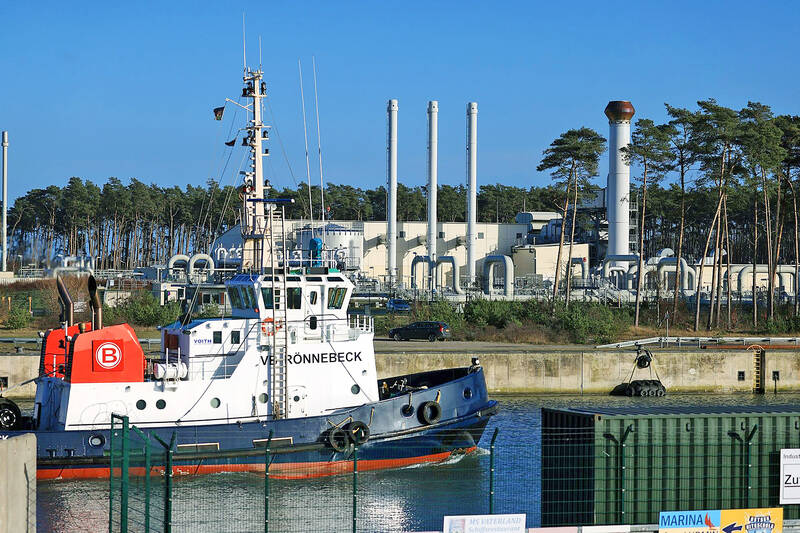The EU is considering a plan to cap the price of Russian diesel at US$100 a barrel — a level that might help to stave off the very worst effects of a fuel-import ban that the bloc is set to impose on Moscow in just 10 days’ time.
The EU’s executive arm is considering the new cap after G7 nations offered a price range based in part on the existing cap on Russian crude oil.
The cap is expected to take effect on Feb. 5, the same date as the EU will ban almost all imports of refined Russian products in response to the nation’s invasion of Ukraine.

Photo: Bloomberg
The EU and G7 plan to impose limits on Russian exports to other countries, whose companies would only be able to access key Western services if they comply.
The US$100-a-barrel cap would apply to products such as diesel that trade at a premium to crude, while a lower US$45 cap would be set for discounted products such as fuel oil, people familiar with the matter said.
The figures could still change during talks between member states, they added.
The negotiations need to balance two competing goals: limiting Russian revenue and preventing price spikes or shortages in key products on the global market.
The EU would need to agree unanimously on price cap levels, which the G7 would need to approve.
EU diplomats began discussing the price levels formally yesterday, and heated talks are expected to continue over the next several days.
European officials have been particularly worried about shortages of diesel after the imports ban, and the price cap is aimed at ensuring that Russian exports can still be sold to other parts of the world, thereby keeping global supplies in balance.
While the EU’s import ban would deprive Russia of its top diesel export market and the bloc of its main external supplier, the price cap is secondary to the import ban, said Richard Bronze, head of geopolitics at consultancy Energy Aspects Ltd.
“The looser the price cap or the higher the price cap is set for diesel, it makes it slightly easier for Russia to redirect some of the exports that would no longer be going to Europe,” Bronze said.
“Even a very high price cap wouldn’t mean that Russia could find alternative destinations for all of those supplies, and I don’t think the US$100 a barrel is anywhere close to what I’d classify as a very high price cap,” he said.
G7 officials expect that Russian diesel currently sold to Europe could find buyers in Latin America and Africa. Europe, meanwhile, is expected to buy diesel from the Middle East and the US, which currently sell more to Latin America and Africa.
The changes could usher in higher shipping costs, as some shipments would be traveling over a longer distance.
The refined-fuel cap comes after the EU agreed late last year to set an upper limit on Russian crude exports at US$60 a barrel.

The US dollar was trading at NT$29.7 at 10am today on the Taipei Foreign Exchange, as the New Taiwan dollar gained NT$1.364 from the previous close last week. The NT dollar continued to rise today, after surging 3.07 percent on Friday. After opening at NT$30.91, the NT dollar gained more than NT$1 in just 15 minutes, briefly passing the NT$30 mark. Before the US Department of the Treasury's semi-annual currency report came out, expectations that the NT dollar would keep rising were already building. The NT dollar on Friday closed at NT$31.064, up by NT$0.953 — a 3.07 percent single-day gain. Today,

‘SHORT TERM’: The local currency would likely remain strong in the near term, driven by anticipated US trade pressure, capital inflows and expectations of a US Fed rate cut The US dollar is expected to fall below NT$30 in the near term, as traders anticipate increased pressure from Washington for Taiwan to allow the New Taiwan dollar to appreciate, Cathay United Bank (國泰世華銀行) chief economist Lin Chi-chao (林啟超) said. Following a sharp drop in the greenback against the NT dollar on Friday, Lin told the Central News Agency that the local currency is likely to remain strong in the short term, driven in part by market psychology surrounding anticipated US policy pressure. On Friday, the US dollar fell NT$0.953, or 3.07 percent, closing at NT$31.064 — its lowest level since Jan.

The New Taiwan dollar and Taiwanese stocks surged on signs that trade tensions between the world’s top two economies might start easing and as US tech earnings boosted the outlook of the nation’s semiconductor exports. The NT dollar strengthened as much as 3.8 percent versus the US dollar to 30.815, the biggest intraday gain since January 2011, closing at NT$31.064. The benchmark TAIEX jumped 2.73 percent to outperform the region’s equity gauges. Outlook for global trade improved after China said it is assessing possible trade talks with the US, providing a boost for the nation’s currency and shares. As the NT dollar

The Financial Supervisory Commission (FSC) yesterday met with some of the nation’s largest insurance companies as a skyrocketing New Taiwan dollar piles pressure on their hundreds of billions of dollars in US bond investments. The commission has asked some life insurance firms, among the biggest Asian holders of US debt, to discuss how the rapidly strengthening NT dollar has impacted their operations, people familiar with the matter said. The meeting took place as the NT dollar jumped as much as 5 percent yesterday, its biggest intraday gain in more than three decades. The local currency surged as exporters rushed to